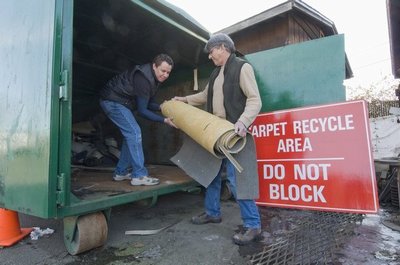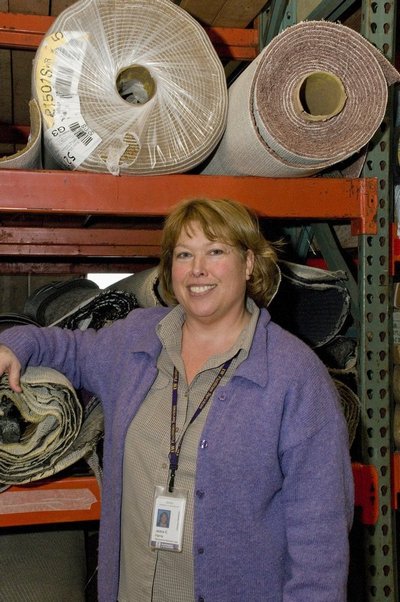January 29, 2009
Saving carpet from the landfill, five tons at a time
By Breona Gutschmidt
Facilities Services
Not long ago, a Facilities Services shop that handles flooring diverted its first dumpster-full of old carpet from a dead end in the landfill to a new life as recycled carpet. After nearly a year of hard work on the part of Maintenance Mechanic Lead Jackie Harris, staff in the shop who install flooring, and Eric Johnson from Transportation Services, the carpet will be recycled into new carpet and other building materials through a company in Tacoma called Recovery 1.
Harris started looking for an avenue for carpet recycling more than a year ago, inspired by Charles Kennedy, associate vice president for facilities services. Kennedy had encouraged Facilities Services divisions to pursue more environmentally friendly practices.
“Taking a serious look at our issues here, it was very clear how beneficial it would be to find a feasible way to join in the ‘go green’ efforts and … recycle the carpet that is removed from the various areas on campus,” Harris said.
Harris knew carpet could be recycled because the company Great Floors, which contracts with Washington State, had carpet recycling stipulated in its contract. “If they can recycle,” she thought, “why can’t we?” Recycling carpet, however, is a fairly new and uncommon practice and the options are limited. The most obvious choice, to recycle UW’s used carpet through Great Floors, would have cost $3 per square yard.
“We were willing to do that,” she said, “but we were concerned — that would have been a huge cost for our clients and for us. So we kept looking for other options.”
The right idea finally came up at a meeting with representatives from two carpet manufacturers — Pat Craft and Interface — with whom Harris works. They suggested she look into Recovery 1 in Tacoma, managed by Terry Gillis. So in May, Harris met with Gillis and toured the facility, which uses innovative methods and hand sorting to recycle a variety of construction debris. When old carpet comes in, Recovery 1 tests the carpet to determine what it is made of and whether it contains dangerous chemicals. Then they separate the fibers from the backing material. The higher grade fibers and the backing are shipped to Georgia or Canada, where they are turned into new carpet. The lower-grade fibers go to vendors for repurposing into other construction components such as insulation and fill.
Recovery 1 charges a reasonable $56 per ton in recycling fees—a huge savings over the $3 per square yard charged by Great Floors, which would have amounted to thousands of dollars. In fact, recycling carpet through Recovery 1 costs less than taking it to the landfill, even when transportation costs for the greater distance to Tacoma are taken into account. At long last, the project seemed possible.
But finding the right recycling vendor was only half of the problem. Back on campus, two issues remained — where to put the carpet while it was awaiting recycling and how to transport it to Tacoma. At first, Harris took the carpet in two 3 1/2 x 3 1/2 foot shipping cubes on the back of a pickup truck. It worked, but was very labor intensive, and with only small storage cubes, the process would need to be repeated once a month.
To solve this dilemma, Harris worked with Eric Johnson from Recycling & Solid Waste to secure a large dumpster. “When the dumpster is full, I call Recycling & Solid Waste; they schedule the university’s contracted recycling and solid waste hauler to take the whole dumpster to Tacoma with a truck and bring it back empty,” Harris said. “It’s much better than using a forklift to get the cubes on a pickup truck and taking it myself once a month. That took a lot of time.”
After six months of filling the bin, the first five-ton load of carpet was delivered to Recovery 1 — and saved from the landfill — last October.
Although the carpet recycling service is relatively new, Recovery 1, which serves homeowners as well as industry, has been in Tacoma for the past 15 years. The company claims a recycling rate of 98 percent of the building debris they take in (including sheet rock, plastic, wood, metal, carpet and concrete). Recovery 1 manufactures a wood fuel product for industrial energy use and designer wood chips on site at its facility, and prepares, sorts and bundles other materials for secondary vendors. For more information, see Recovery1.com.
With increasing consumer demand and growing successes like that at the UW, the carpet manufacturers Pat Craft and Interface are also eager to get in on the recycling game. They’d like to start providing an outlet to their customers for recycling.
“They have been talking about making Seattle a point of manufacture for carpet recycling,” Harris said. “Now . . . recycled carpet goes to Georgia, where most carpet is made.” She said the development of a Seattle carpet recycling plant is a few years away, but she’s excited to be a part of the larger movement for carpet recycling in our region as well as a participant in recycling on campus.
Recycling is not the only way Harris’ shop saves carpet from being thrown away. It also offers remnants of unused carpet to clients for free, charging only the cost of labor for installation. Anything unclaimed by the departments goes to the surplus store, so nothing is wasted.
“Our shop is also able to offer clients who are looking to install new carpet material selections that are made partially or entirely from reclaimed carpet,” Harris said, “and when that carpet is removed, it will go back to the manufacturers to be made again into new carpet.”
The carpet recycling project is a perfect example of achieving success by starting small, being persistent and creating partnerships both across campus and with outside vendors in the community. Harris says that she and the shop staff take pride in their efforts to “go green” and in personally doing something to save the environment.




